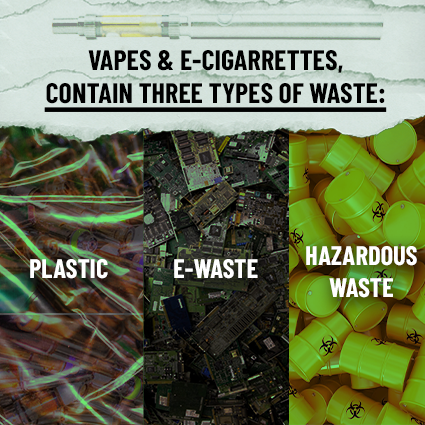
While the effects of vaping are often focused on the individual user, the pollution created by vaping and vape devices is becoming a big problem that affects everyone, whether they choose to use or not.
How Does Vaping Impact the Environment?
Vaping poses a unique threat to the environment because of the difficulty in breaking down its components. Vapes or e-cigarettes contain three different types of waste: plastic waste, electronic waste, and hazardous waste, making them uniquely difficult to dispose of.12
Even under severe conditions, vapes will never biodegrade—they will only break down into microplastics and chemicals that pollute waterways and are almost impossible to clean up.12
What Is Being Done About It?
Learning how to protect yourself and the environment is a great first step. You can make an even bigger difference by sharing your knowledge with others. Government agencies have also started to create clearer guidelines for disposing of vaping waste safely.
In 2022, California passed a new law (AB 1894) about cannabis vapes and cartridges.3 The law set new rules for how companies can label and advertise cannabis vape products.
The law has two main parts:
- When companies advertise vapes, they have to include information about the right way to dispose of these products.
- Product packaging can’t suggest that these items are disposable or that it’s okay to throw them away in regular trash or recycling.

What is the Safest Way to Dispose of Vape Products?

- Check the packaging on vape products for safe disposal recommendations or offers for recycling programs. Some stores that sell vapes also offer recycling services.
- Local waste departments often accept vapes and e-cigarettes. There are several different ways to search for drop-off centers in your area.
The DEA (Drug Enforcement Administration) accepts vaping devices and cartridges during their National Takeback Days. Find DEA takeback dates and locations through their collection site locator.
Sources:
1. A toxic, plastic problem: E-cigarette waste and the environment [Report] (2021). Truth Initiative. https://truthinitiative.org/research-resources/harmful-effects-tobacco/toxic-plastic-problem-e-cigarette-waste-and-environment
2. Beutel, M. W., Harmon, T. C., Novotny, T. E., Mock, J., Gilmore, M. E., Hart, S. C., Traina, S., Duttagupta, S., Brooks, A., Jerde, C. L., Hoh, E., Van De Werfhorst, L. C., Butsic, V., Wartenberg, A. C., & Holden, P. A. (2021). A review of environmental pollution from the use and disposal of cigarettes and electronic cigarettes: Contaminants, sources, and impacts. Sustainability, 13(23). https://doi.org/10.3390/su132312994
3. CA Department of Cannabis Control. (n.d.). AB 1894 requirements for packaging, labeling, advertising, and marketing cannabis cartridges and integrated vaporizers. https://cannabis.ca.gov/2024/06/ab-1894-and-new-requirements-for-packaging-labeling-advertising-and-marketing/

